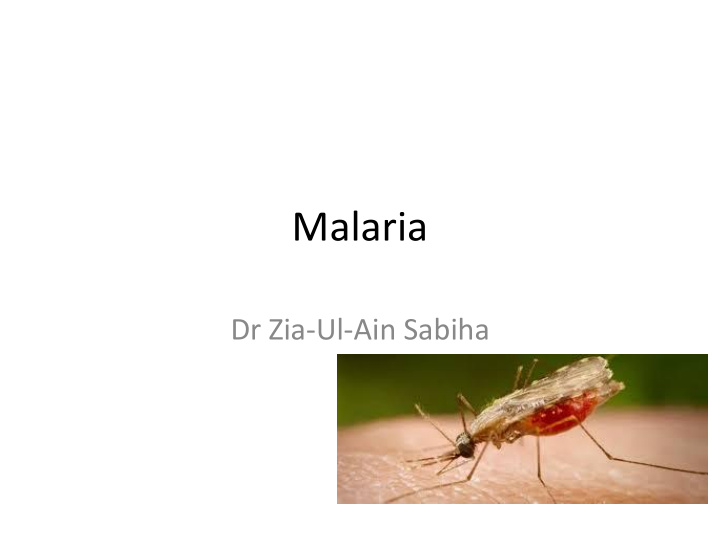



Malaria Dr Zia-Ul-Ain Sabiha
Introduction • A protozoal Disease Caused by genus Plasmodium • Transmitted to man by certain species of infected female Anopheline mosquito. • Typical attack Comprises 3 distinct stages Cold stage, hot stage, and sweating stage
Severity of disease • Severity of disease vary form mild to severe and complicated according to – Species of parasite present – The patient state of immunity – The intensity of infection – Malnutrition – Other diseases
Who Is Most Vulnerable? • Young children • Non- immune pregnant women – ( miscarriage ,Low birth weight) • Semi -immune pregnant women(high transmission areas) • Semi -immune HIV infected pregnant women • People with HIV/AIDs • International travelers from non endemic areas • Immigrants From endemic areas and their children
Statistics • 3.2 billion people (half the world’s population) live in areas at risk of malaria transmission in 106 countries and territories • In 2012, malaria caused an estimated 207 million clinical episodes, and 627,000 deaths. An estimated 91% of deaths in 2010 were in the African Region. https://www.cdc.gov/malaria/malaria_worldwi de/impact.html
Situation in Pakistan • With an estimated burden of 1.6 million cases annually, malaria is considered as a major public health problem in Pakistan. • It contributes 22% of total disease burden in the Eastern Mediterranean Region (EMR) and has been grouped with Sudan and Yemen in category 3 countries . • Epidemiologically, Pakistan is classified as a moderate malaria endemic country with national API( annual parasite index) averaging at 1.69 and important diversity within and between the provinces and districts. • The two parasites which account for malaria in Pakistan are Plasmodium Vivax and Falcipaum. • The main vectors in the country are Anopheles Culicifacies and Anopheles Stephensi.
Diagnosis and Treatment • Early Diagnosis( WHO recommends) – Parasite based diagnostic testing • Microscopy • Rapid diagnostic test • Treatment – ACT(Artemisinin- based combination therapy)
Preventive Measures • Insecticides- treated mosquito nets • Indoor spraying with residual insecticides • Insecticide resistance – Vector control with Pyrethroids • Elimination
Elimination • Elimination is defined as interrupting local mosquito born malaria transmission in a defined geographical area, i,e zero incidence of locally contracted cases. • Malaria eradication as defined as the permanent reduction to zero of the world wide incidence of malaria infection caused by a specific agent; i.e applies to a particular malaria parasite species.
Malaria control strategic plan 2015- 2020 Pakistan entails developing innovative strategies that will: a. Improve the performance and impact of malaria control in Pakistan with maximizing public sector investment and accountability in malaria control activities b. Reduce diagnostic delay related to malaria and improve the efficacy of treatment c. Prevent malaria disease by effective vector control interventions with universal coverage of LLINs(long lasting insecticides nets) and selective IRS(indoor residual spraying) d. Better surveillance and program management e. Prioritize research that has the potential to change policy and practice in malaria care in the province
MALARIA CONTROL PROGRAM PAKISTAN: VISION, GOAL AND OBJECTIVES • Vision • Malaria free Pakistan
Goal • By 2020, reduce the malaria burden by 75% in high and moderate endemic districts/agencies • and eliminate malaria in low endemic districts of Pakistan
• Objectives • 1. To achieve <5 API in high endemic areas of province of Balochistan, Sindh, KP and FATA region by 2020 • 2. To achieve <1% API within moderate endemic districts of Balochistan, Sindh, KP and Punjab by 2020 • 3. To achieve Zero API within low endemic districts of Sindh, KP and Punjab by 2020
Roll back Malaria
Action and investment to defeat malaria 2016 and 2030 Goals Milestones 2025 Targets 2020 2030 Reduce malaria mortality rates globally At least 40 % At least 75% At least 90 compared with 2015 % Reduce malaria case incidence globally At least 40 % At least 75% At least 90% compared with 2015 Eliminate malaria from countries in At least 10 At least 20 At least 35 which malaria was transmitted in 2015 countries countries countries Prevent re-establishment of malaria in all Re- Re- Re- countries that are malaria free establishmen establishme establishme t prevented nt nt prevented prevented
• Recent years have seen extraordinary advances in the fight against malaria,but the gains are fragile and unevenly distributed. Victory against the malaria parasite would rank among the highest achievements in human history. To reach the 2030 malaria goals and bring our vision of a malaria-free world within reach, we must: • Combine forces to defeat malaria and recognize the important role that all stakeholders, including non-health sectors, play in the reduction and elimination of malaria, • Demonstrate continued progress and show that reducing malaria is critical to achieving the Sustainable Development Goals, • Expand partnerships work across countries, and call on stakeholders in all areas to participate and intensify their engagement in the fight against malaria, and • Accelerate efforts and act with urgency to reduce the number of people suffering and dying from a preventable and treatable illness and achieve malaria elimination locally, nationally, and regionally as soon as possible.
Recommend
More recommend